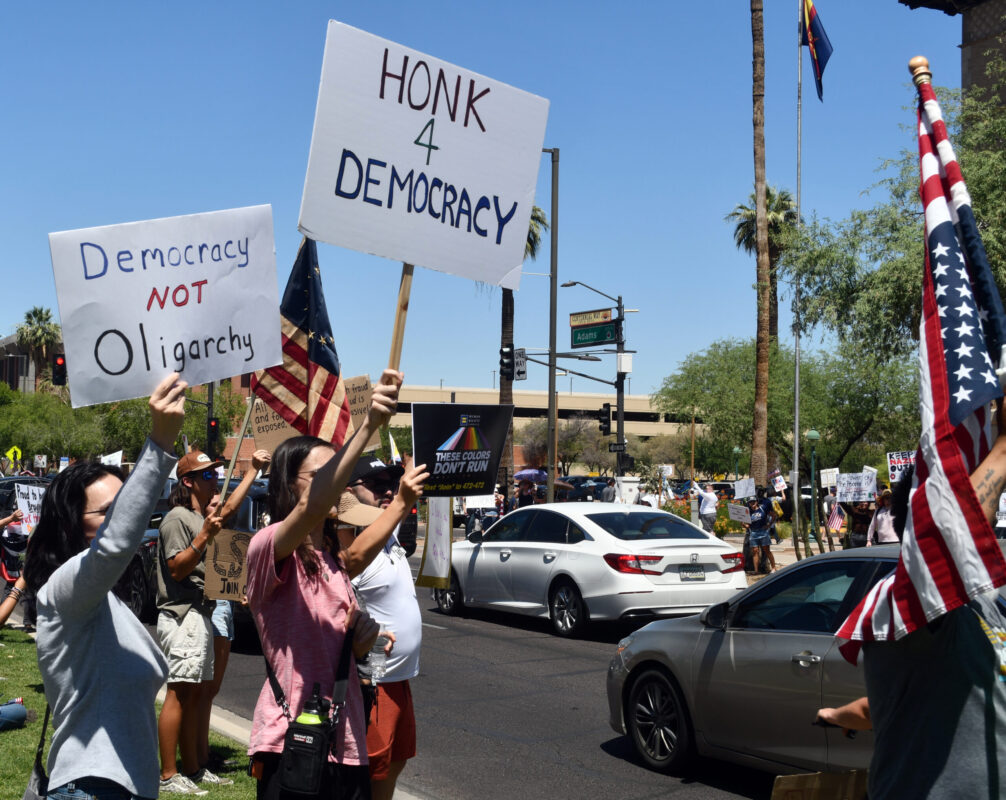Key Points:
-
New study finds those who buy political merchandise less likely to volunteer, vote
-
Research head said there’s an ‘irony’ in the findings
-
Findings could signal to candidates to shift message to supporters
Sure, it’s nice to buy a cap, a T-shirt or even a coffee mug with the name of your favorite candidate.
But some new research suggests you’re far less likely to turn out on election day to help that candidate than if you had donated the same amount of money.
Anastasiya Ghosh, a marketing professor at the University of Arizona who headed the research team, said those who participate in the high-visibility support by purchasing campaign swag also are less likely to volunteer to help that candidate’s campaign than those who give small amounts of money.
And Ghosh said her research gives her a pretty good idea why: People who do things that are visible to others seem to believe they’ve done their bit for the cause. And at that point, she said, they are less likely to follow through with the less-visible things, like volunteering — and, in this case, voting.
“Me, buying something and carrying it around, using it in my household, others observing me, seems that I have done more for the candidate,” she explained of the attitude of those who flout campaign items.
But Ghosh said, there’s a certain “irony” in all that. She said those visible acts actually can hurt.
“If I’m a campaign manager, you buying a T-shirt from me is a lot less lucrative for me, if you will, than you giving me that money right away,” she said.
“I have to create a T-shirt, I have to ship it to you, and the money that’s left over is really small,” Ghosh continued. “But me, as a consumer, I feel like I’ve done more for you.”
The message to campaign managers, she said, is to place a little less emphasis on getting supporters to wear their candidate’s T-shirt — and a little more on getting them to the polls.
At least part of the effect, she said, is whether others will notice.
One experiment cited involved asking people to wear a candidate’s T-shirt. Some were told they would be wearing it in a nearly empty grocery store; others were told they would be in a more crowded spot.
“The effect was much stronger when other people were around,” Ghosh said, with those who were more visible less likely to then do other things like convince undecided voters.
All that, she said, ties to her conclusion that visibility matters. It’s called “impression management,” which includes a desire to be seen.
“If I have made my donation to a candidate, in most cases, nobody knows about it,” Ghosh said.
“If I spend an equivalent amount of money to put a T-shirt on myself with the name of my candidate, I understand that other people will see,” she said. “If I’m surrounded by people who are similar to me, that’s probably a positive impression.”
All this, she told Capitol Media Services, provides a crucial lesson for those running candidate campaigns: Selling those buttons and bumper stickers won’t necessarily translate into victory on Election Day.
Still, she said, there may be times when the more visible signs of support, like T-shirts and the yard signs, are more valuable to a candidate — even if the people buying the items don’t turn out at the polls.
“When you’re starting out the campaign … your goal is to signal to the world or your constituents that you have a very popular candidate,” Ghosh explained. “Maybe it’s worth investing into asking for merchandise that will be publicly worn.”
“Maybe the person who bought it is not going to be a voter,” Ghosh continued. “But maybe others who will observe it will.”
But that effect, Ghosh said, only goes so far.
Put another way, she said a candidate may have to tell someone that it’s great they put out a yard sign, “but I need you to show up.”
She even has given a name to all this: political slacktivism, a term Ghosh said was suggested by one of her students.
“I do demonstrate that I’m engaged,” is the attitude of those buying or displaying merchandise or signs, she said.
“I support my candidate,” Ghosh said. “But I’m not doing the hard thing, which is actually showing up to vote.”
Ghosh said she found the same effect where people who purchase candidate campaign items are less likely to volunteer their time, make phone calls and go door-to-door to drop off campaign materials.
These conclusions, she said, are based on multiple sources of information.
Ghosh said historical data dates back to 2016, when people were asked whether they had yard signs and bumper stickers, and whether, in the end, they voted. That, she claimed, was designed to eliminate aberrations in the data.
She also reviewed surveys conducted during the 2020 national election among people who declared themselves supporters of one party or the other. They were monitored from the time of the national conventions through November.
What that showed, Ghosh said, is that those who bought political swag were 91% less likely to go to the polls than those who had made financial donations.
Finally, there were studies done with students.
In one case, some students were told they made a small donation in the form of buying a $5 political button. Then they were given the button and told to wear it.
Other students were simply told that a $5 donation was made on their behalf.
In both cases, students were asked how many text messages they would be willing to send out on behalf of the party and how many calls they would make for the party. The result? Ghosh found those who got the merchandise were less likely to have further engagement with their political party than those who were told they had given money.



